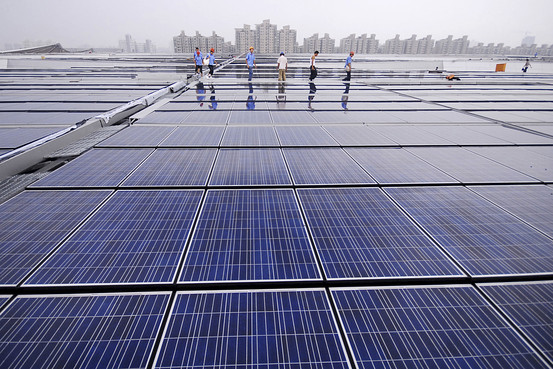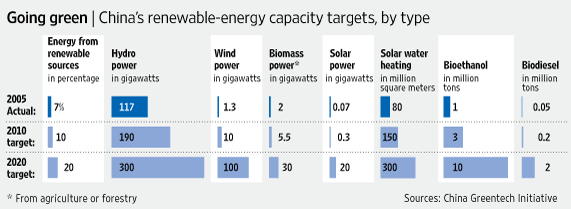|
|


ADVERTISEMENT
Buy Your own advertising
spaces!
.
Download Adobe Acrobat Reader to open [PDF] files.
Recent Visitors
Optimism for Clean-Technology Market
2009. 11 September
A group of Western companies says it can see a $500 billion to $1 trillion market annually for clean technology in China, according to a report published Thursday meant to highlight how a big new industry might develop in the world's most populous nation. by James T. Areddy
by James T. Areddy
(online.wsj.com)
Report by Western Companies Attempts to Draw Attention to The Vast Potential for a New Industry in China
The China Greentech Report 2009 outlines more than 300 clean energy, construction, transport, water and other businesses that might realistically open in China. The report was assembled by a group called China Greentech Initiative, made up of more than 80 predominantly large Western companies and organizations with interests in the environmental sector. The headline figure of up to $1 trillion annually reflects revenue the group says ultimately could be generated from widespread adoption of cleaner solutions, a best-case scenario given expectations about China's growth trajectory.
The figures are neither a projection, nor is the report the first attempt to draw attention to the seemingly vast market potential in China. "The story that has emerged is largely an optimistic one, tempered by the complexity of China's markets and the challenges that must be overcome," says the report.
The report's outline of China's potential market size for companies from China, the U.S. and other countries is designed to convince government and corporate policy makers that spending money to tackle the world's environmental challenges will have a financial payoff.
China, the world's fastest-growing resources consumer, and the U.S., the biggest, together generate 40% of global emissions and use a third of the energy. Support by leaders of these countries for corporate clean-technology efforts, at forums such as a major climate conference planned for December in Copenhagen, is therefore considered crucial.
Today, without government support, many wind, water, solar and other clean technologies don't yet make financial sense.
When projects do get government backing, they can be on a grand scale.

This week, China's government gave preliminary approval for an Arizona-based company, First Solar Inc., to develop a colossal system of panels over the coming decade to produce 2 gigawatts, or 2 billion watts, of electricity in the desert of Inner Mongolia. Yet questions remain as to just how big the project is, such as how many billion dollars it may cost, how funding will be arranged and how its power output will be priced.
Earlier this week at a Greentech Initiative conference in Shanghai, Fu Zhihuan, a senior Chinese legislator, summed up the bilateral relationship by noting the U.S. has "technology, capital and expertise." Mr. Fu added, "China has huge markets."
How likely businesses will be to realize the growing ambition remains unclear.
China and the U.S. have already signed at least 17 bilateral agreements on the environment in the past 12 years. Still, corporate executives at this week's Shanghai conference blamed both nations for holding back progress through trade barriers, trade secrets, trade-finance difficulties and other issues.
The Greentech Initiative group takes an optimistic view: A summary section of the report outlining opportunities extends to 24 pages, while a chapter on challenges stops at 13 pages. Elsewhere, the report dives deep into technical areas such as how companies might focus on building "smart grid" electricity power systems for China, and the barriers to doing it.
Big-picture business opportunity and challenges relating to China are well-known, and are rarely unique to the clean-technology industry.
In May, consultants at McKinsey & Co. , for instance, published a study that said China could reduce its demand for imported oil by 30% to 40% more than it has already said is possible. But realizing such goals would require massive changes in mindset, as well as allocation of up to $290 billion annually specifically to do it, the firm said.
Write to James T. Areddy at james.areddy@wsj.com
Source: online.wsj.com

